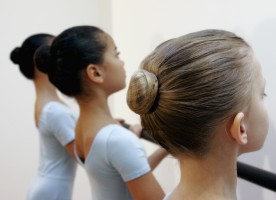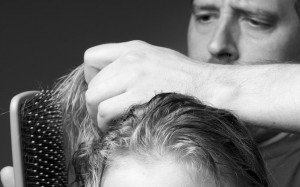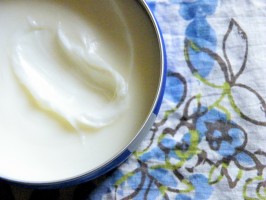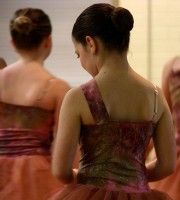With a host of experienced dancers and dance teachers reading this I am confident there is no need to provide any step-by-step instructions for producing the perfect ballet bun. That said, there is one area often neglected:
…the student experience.

For generations, young dancers have endured having their hair roughly manhandled by parents and teachers – usually in a hurry to get the next student ready – and have tolerated the pain and discomfort of having their scalps scratched and scraped, hair yanked from the roots and pins stabbed into their crown, all the while being told to be quiet, stop whinging, and most of all sit still ! (Sound familiar?)
Beyond the often brutal act of screwing the hair into a bun in the first place, there are also other issues which may plague and distract the dancer throughout their exam/performance long after the bunmaker has moved on; the off-putting sensation of a not-centered ponytail, the distraction of painfully placed pins, the off-balancing effect of a bun-coming-loose.
Now, there may well be little lasting harm done to these dancers by putting up with this, yet, I advocate that a comfortable dancer is a happy dancer, and I believe in prioritising our students’ welfare. Moreover, a happy dancer is more likely to perform better.
By making the bun-making process as painless and the bun itself as comfortable as possible, not only are we making happy dancers, but we may well indirectly boost their exam results.
Here are a few things that can be helpful to remember if acting as hairdresser, and tips on how to overcome regularly encountered problems:
Hypoallergenic Products
If you are providing hair products for the students, check in advance that, wherever possible, they are hypoallergenic to avoid any risks. As this can be a more expensive option, perhaps officially add ‘hairdressing’ as a service you will be providing on the day, and charge a small extra fee to all students to cover costs.
Brushes & Combs
Make sure you have to hand a variety of brushes and combs to accommodate different hair types:
- Curly, unruly and thick hair is usually best managed with brushes with strong/coarse wide-spaced bristles (the Denman styling brush
is ideal), whereas tighter-packed or bendy bristles often generate frizz (read: knots) without managing to actually detangle.
- Radial/round brushes and those with a small ball on the end of each bristle should be avoided for students with thick/curly hair as they often cause painful-to-remove tats and knots.
- For lighter/fine hair, baby-soft bristles should be used, as the strong bristles for curly hair will be too painful.
- Sparse-density hair requires soft tightly-packed bristles, so as to avoid separating the hair too much and leaving the scalp visible (which some dancers find embarrassing or even upsetting).
- Lastly, it should be remembered that Paddle brushes, whilst versatile, are not the most suitable when attempting to contour the hair into a tight smooth ponytail – particularly on smaller heads!

Hair Ties/Bands
Have on-hand different types of hair ties (also called ‘hair bands’ or, in the UK, ‘bobbles’). While useful for light hair, thin hair ties, particularly if they have a metal clasp, should be avoided for thicker hair as they tend to snag at the hair and cause knots. Thin ones should also be avoided for thick or very long hair, as they usually have less elasticity, and are more prone to snapping under force.
Hair ties with ornaments or decorative pieces such as small plastic ballet shoes etc. should be entirely avoided as they can easily get knotted into medium-thick hair (especially if curly), and often need to be cut or ripped out. For the same reason, avoid hair ties with a scratchy or rough surface.
Bonus Tip: A good home-made option is to cut up the legs of a pair of opaque tights into 1-2inch loops. This is great as this material doesn’t snag at the hair, is easily put in/taken out, has great stretch for getting that ‘last twist’ you so often long for with the ‘bad bobble’, and you can pick colours which blend in very well with different hair colours.
Hair Brushing & Detangling
Often it is quickest and easiest to get the student to brush their own hair to get rid of any tats/knots, followed by your own quick pre-styling brush through. This way they are in control, and when things get uncomfortable they can make accommodations to tackle difficult spots, rather than wince as an adult ploughs through.
If the student is too young to brush their own hair, avoid rough strokes and be mindful of their body language (if you have a quiet one!) A good tactic is to start at the bottom and work your way up, rather than starting at the top and risk matting tangles by dragging them down-over. Also, when tackling big knots, hold the hair tightly near the scalp but slightly away from the head; that way, the pressure of pulling and tugging on the hair is against your own hand, and is not felt by the student. Spritzing with water or Detangler can also be useful tactics.

The Ponytail
Invite the student to put their hair in a tight high ponytail themselves if they are able. This is often the most difficult part for a parent/teacher to get right as there are so many variables, and only the student can sense where it feels most comfortable and secure. If they are not old enough to manage it on their own, double check that they are satisfied before continuing to avoid whinging later when it’s too late!
Construction Errors
Do not underestimate the level of discomfort or distraction of a bad bun! If mid-construction take the time to un-do any problems and remake so as to avoid hours of irritation. If the bun is already complete, and the issue not as simple as removing a last-added stabbing pin, apologise to the dancer saying you will have to prioritise with other students but that you will try to re-do their hair if there is time before their session.
Pin Placement
When poking pins into a forming bun, it is tricky to avoid occasional head-stabbing. While there doesn’t seem to be any tactic which is entirely fool-proof, I recommend aiming the pin downwards on an angle to push it in (towards the head, but slightly out/away from the bun), then press it up/into the centre of the bun in a sort of swooping ‘down up’ curve so as to catch the hair and anchor the bun, but avoid aiming the pin towards the scalp at any point. Other than this I recommend practice, and patience!
Hair Gel
Be cautious when applying hair gel so that as little gets on the skin as is possible; its stickiness can be very unpleasant. Also, double check in advance that there are no sparkles or colouring in the gel to avoid messy accidents, or embarrassing skin staining.

Hairspray
When using hairspray, always make sure you first tell the student to close their eyes and put your hand over their face to avoid it getting in their eyes. This also helps reduce the amount of spray accidentally landing on faces. Before hair spraying, always make sure you say “deep breath” (or some equivalent) to the student, so as to both warn them they are about to be sprayed, and make sure to avoid any miss-timed breathing accidents.
Finishing Off
The sensation of sticky residue on the skin from hairspray is disagreeable and unpleasant for many. When the bun is complete, offer the student a wet-wipe/baby wipe to remove any excess sticky residue on their faces and ears from the hairspray. While may wish to do this for students who are young (or less trustworthy), do remember that they are the only ones who can feel where the sticky spots are!
Bun Making Masterclass
Ultimately, the best solution to bun problems is to entirely remove the middle man, and teach the students to do their own hair as early as possible. In a majority of recreational schools students might be asked to tie their hair up, but are rarely expected to wear their hair in buns for all classes, and certainly strict professional-level-tidy buns are usually only ever mandatory for exams or performances.

Because of this, students are ill-used to correctly putting up their own hair, so when it comes to exams and performances, parents and teachers are forced to step in to ensure students hair that is both well presented, and sufficiently secure.
Now, many teachers feel that despite this issue, they are not comfortable making ballet buns compulsory for all classes so as to accommodate for individual students home lives and circumstances etc. Yet, an alternative option is to offer a free ‘Bun Making Masterclass’ at the start of each year, during which students are taught techniques on how to put their hair up to a high standard independently.
Possibly this could be developed into a competition as to who has created the strongest or neatest bun, either for the end of the workshop, or even continued throughout the rest of the year (the element of competition ideally helping retain interest and a desire to put their hair up for all classes).
This way, students will not only become proficient at their own buns for exams and performances, but they will be adopting the discipline of putting ones hair up for ballet like a pro, without necessarily even realising it.

Bonus Tip: As part of the ‘Bun Making Masterclass’, give out standardised instruction booklets for students to follow during the Masterclass, and to take home with them for future reference (and for their parents!). Do include pictures of inspirational professional dancers as motivation, and include information like;
♦ what to do with fringes ♦ what to do with short hair ♦ what bun nets etc. do you want them to use (standardised, or blending with their hair colour for example) ♦ how high do you want them to place their bun (nape of the neck, back of the head, high on the crown) ♦ what partings you would prefer ♦ what decorations (scrunchies, ribbons etc) you permit, and of course ♦ advice on appropriate use of gel/hairspray/products etc.
This way you are most likely to have a studio full of beautifully matching, expert-standard ballet buns; not only raising the level of professionalism in class, but ensuring their skills are well honed for exams and performances.
Share your best bun-crafting tips in our comments!
If you have questions, post those, too.
Angeline Lucas is a freelance dance writer, teacher and lecturer based in England. She has been awarded Registered Teacher Status with the Royal Academy of Dance (RAD) and is an Approved Teacher of the Council for Dance Education & Training (CDET). Angeline trained at Northern Ballet School (NBS) and holds a Certificate of Higher Education in Dance Education, validated by RAD and the University of Surrey. Previous roles have included working as head of department, outreach coordinator and curriculum manager, and she also has experience in dance research and arts administration. Angeline has taught and lectured at various private dance studios, schools, colleges and on community programmes, and is considered to be a dedicated, experienced and enthusiastic teacher. Angeline’s greatest passion is classical ballet, and is devoted to the advancement of the art form, the promotion of accessible high-standard dance education, and facilitating the achievement of her students.

